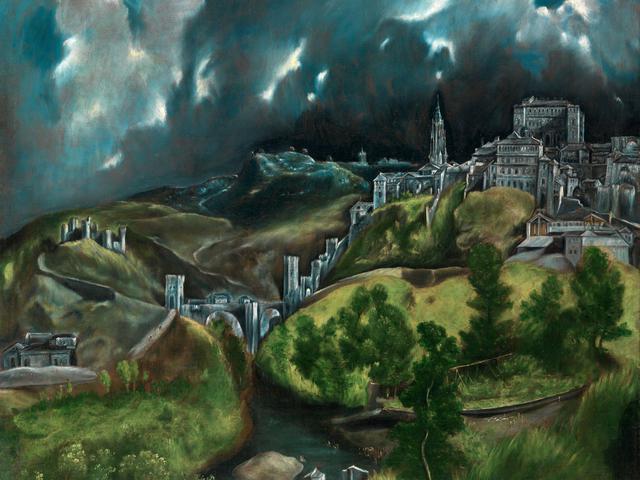View of Toledo

Born on the island of Crete, where he trained in icon painting, El Greco, also known as Domenikos Theotokopoulos, studied Venetian painting under Titian (1485-1576) in Italy, where he also absorbed the language of Mannerist painting from a variety of artists, including Tintoretto. (1518-94), Jacopo Bassano (1515-92) and Parmigianino (1503-40), for example, the latter's Madonna With the Long Neck (1535), as well as Michelangelo (1475-1564). An intense, intellectual and spiritual man, in 1577 he left Italy for Spain, where he completed numerous religious paintings for the Spanish Church. These works were executed in accordance with the new guidelines issued by the Council of Trent (1545-63) for the creation of Catholic Counter-Reformation art (1560-1700). Indeed, despite falling with Philip II, El Greco's non-naturalistic painting style proved an ideal vehicle for conveying the spiritual intensity of the Catholic faith in the homeland of the Spanish Inquisition.
One of his famous paintings View of Toledo had the simplest and most usual elements of a landscape painting such as the sky, the hills, a city, the deep gorge of a river, trees, meadows, roads, but the main things such as the feeling of space, of Distance, are missing. Dominant, however, is what in painting is usually transmitted only by the human figure: the feeling of activity, of drama. The sky is catastrophically ruined in a chaotic torrent of its clouds; while the earth rushes to meet it in an ascending wave. The movement of the mountain roads, now crossing each other, now separating, forms a curious ornamental and active pattern of interlocking triangles. There is a strange rearrangement of Toledo's topography: the cathedral located on the wrong side of the castle; the imaginary city gate with trees; The changed architecture of the towers of the Alcántara bridge. The city is presented full face and in profile, and there is a subtle contrast between this plain, which includes the ornamental flight of the roads and the bulging of the great clouds, swollen by the lights of the sky, the anger of the sky and the blue from the sky.
The painting is not an accurate representation of the city at that time. The perspective of the city is the east side as seen from the north. However, the artist wanted to include the cathedral, which would not have been visible from the chosen perspective, so he moved it to the left of the old Moorish Alcazar.
© Tourblink